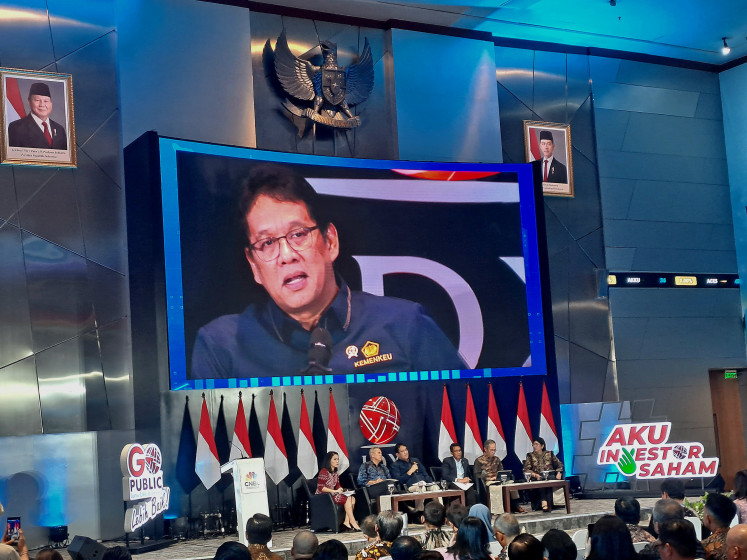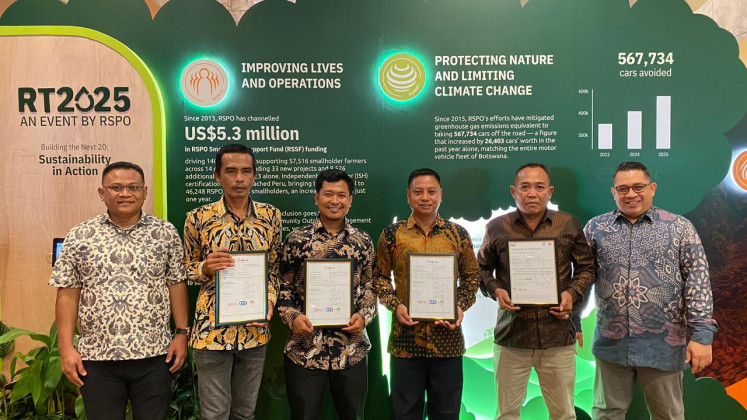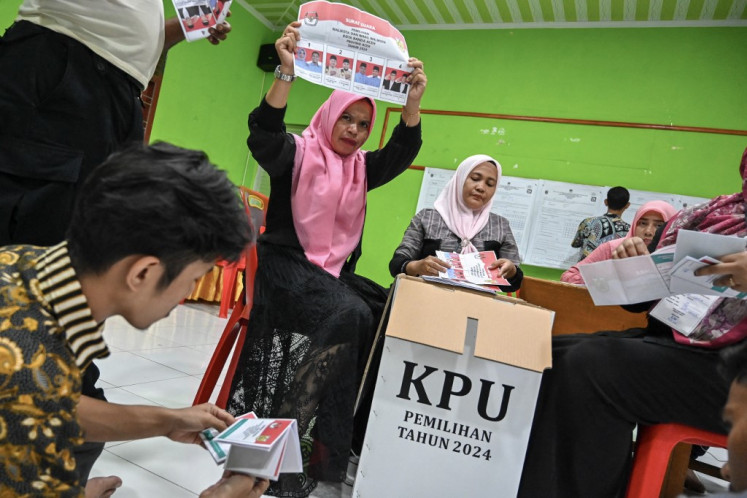Popular Reads
Top Results
Can't find what you're looking for?
View all search resultsPopular Reads
Top Results
Can't find what you're looking for?
View all search resultsIndonesia’s potential for cross-border ASEAN tourism
To compete with its neighbors, Indonesia must reframe regional tourism as a strategic priority rather than a side focus. This requires targeted action across three main areas: Destination development, air connectivity and service quality.
Change text size
Gift Premium Articles
to Anyone
Indonesia still lags behind neighboring countries in attracting international tourists. In 2024, Indonesia welcomed approximately 13.9 million foreign visitors, whereas Thailand received 35.5 million, Malaysia 25 million, Vietnam 17.6 million and Singapore 16.5 million.
Going forward, Indonesia should formulate a strategy to increase tourist visits, as the foreign exchange revenue from the tourism sector can play a large role in reducing Indonesia’s current account deficit.
A key question is whom we should target: Tourists from advanced countries, such as Japanese, European or American tourists, as their per-capita income is already high; or cross-border tourists from neighboring ASEAN countries?
Our data investigation shows that the pool of tourists in ASEAN is sufficiently large and a vital component of cross-border tourism in the region, indicating great potential for business opportunities.
According to recent data, around 45 percent of the 129 million international visitors to ASEAN in 2024 were from within ASEAN.
In 2024, the top three source countries of ASEAN tourist visits to Thailand were Malaysia, accounting for 13.93 percent of total visitors, followed by Lao PDR (3.16 percent) and Indonesia (2.47 percent). Meanwhile, Malaysia received the majority of its ASEAN tourists from Singapore (36.37 percent), Indonesia (14.60 percent) and Thailand (6.55 percent). For Vietnam, key source markets within ASEAN included Malaysia (18.27 percent), Cambodia (16.77 percent) and Thailand (15.81 percent). Singapore saw the highest number of ASEAN visitors coming from Indonesia (15.06 percent), Malaysia (7.17 percent) and the Philippines (4.71 percent).
The advantage of cross-border tourists is that they tend to visit repeatedly and consistently, with less fluctuation in arrivals and a potentially large number of visitors, which can increase tourism revenue and foreign exchange earnings.
The reasons for strong intra-ASEAN tourism are proximity, shared cultural traits and affordable travel. More importantly, regional tourists are not just a secondary market, rather they are a core economic driver. With more frequent travel patterns and higher revisit rates, ASEAN travelers present a strong opportunity for growth.
However, Indonesia accounts for only 6.54 percent of this market, indicating a relatively small share of tourist visits from ASEAN countries. To compete with its neighbors, Indonesia must reframe regional tourism as a strategic priority rather than a side focus. This requires targeted action across three main areas: Destination development, air connectivity and service quality.
First, enhancing regional gateways Batam and Bintan. One of the leading entry points for foreign tourists to Indonesia is Batam, strategically located near Singapore and Malaysia. In 2024, Batam welcomed approximately 1.3 million foreign visitors, accounting for 9.47 percent of all international arrivals to Indonesia. Its location makes it a natural hub for cross-border tourism.
However, the surrounding areas, especially Bintan Island, hold even greater potential. With investments in resorts, beaches, golf courses and water sports, Bintan can become a top-tier tourism destination. Its natural beauty and relaxed atmosphere appeal to short-haul travelers seeking quick getaways.
The upcoming Batam-Bintan Bridge is a transformative infrastructure project that will improve inter-island access and encourage integrated tourism development. Creating a seamless Batam-Bintan corridor can attract more regional visitors and encourage longer stays.
Focusing on such border regions that are already closely connected to neighboring countries can accelerate Indonesia’s ability to tap into ASEAN’s high-volume tourist flows.
Second, strengthening air connectivity. Ease of travel remains a decisive factor for tourists, especially in the ASEAN region. Regional travelers prefer direct routes from their cities to tourist destinations to minimize time and cost. Unfortunately, Indonesia has experienced a reduction in key international flight routes, which could hinder regional tourism growth.
For example, the Medan–Kuala Lumpur route has seen a decline in services. Major Indonesian carriers like Garuda and Citilink have ceased operations, leaving airlines like AirAsia, Malaysia Airlines and Batik Air to maintain the connection. Similarly, airports in Bandung, such as Husein Sastranegara and Kertajati, have lost most of their international links, with only the Kuala Lumpur route remaining. Previous flights to Singapore and Bangkok have been suspended. Previously, there were direct flights between China and Manado, but they have not yet been reopened.
Restoring and expanding these direct connections is crucial. Without reliable and convenient routes, Indonesia risks losing travelers to more accessible alternatives. Strategic partnerships with airlines, route subsidies and coordinated promotions with tourism boards can help reestablish vital regional links. With more direct flights to key ASEAN cities, Indonesia can become a more viable choice for spontaneous, short-term or weekend travel, which is popular among regional tourists.
Third, improving the tourist experience. Tourism is not just about attractions; it’s about experience. How visitors are treated, the ease of their journey and the services they receive all influence whether they will return or recommend the destination.
Indonesia must enhance its service quality across the board. This includes training front-line tourism workers to provide warm, professional hospitality, modernizing immigration and visa processes through digital solutions, ensuring efficient and clean public amenities and supporting language accessibility for ASEAN visitors.
Moreover, embracing digital tools, such as mobile apps for itineraries, translation and navigation, can elevate the visitor experience, especially for younger ASEAN travelers who prefer mobile-first interactions.
Tourists who have smooth and enjoyable experiences are not only more likely to return, but also become brand ambassadors, sharing their experiences on social media and in their communities.
Historically, Indonesia has focused heavily on long-haul markets, such as China, Europe, Japan and Australia. While these remain valuable, regional tourism within ASEAN offers a more immediate and cost-effective growth opportunity. ASEAN residents tend to travel more frequently and are more resilient to global shocks, such as pandemics or geopolitical tensions that disrupt long-haul travel.
Tapping into this market means lower acquisition costs, quicker return visits and more direct spending in local economies. In fact, ASEAN tourists often engage more with community-based tourism and small businesses, making their contribution even more inclusive.
Indonesia stands at a pivotal juncture in its tourism strategy. The current gap in regional tourist arrivals is not due to a lack of potential, but rather an underutilization of it. With 45 percent of ASEAN tourism flows coming from within the region, the opportunity is both substantial and sustainable.
To fully capitalize on it, Indonesia must focus on strengthening regional gateways like Batam and Bintan, restoring direct flight routes and investing in high-quality visitor experiences. Note again that cross-border tourists offer a strategic advantage due to their consistent travel patterns and high likelihood of repeat visits, contributing to a stable flow of arrivals and enhancing both tourism income and foreign exchange gains.
*****
The writer is an analyst at Bank Mandiri.










